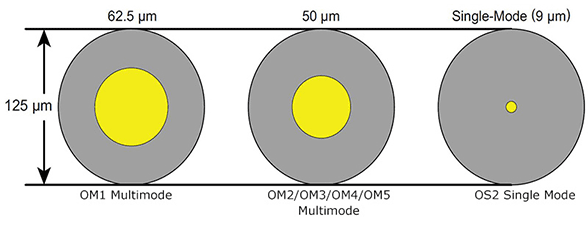Multimode cable has a large-diameter core that lets multiple modes of light pass through it. This means that more types of data can be transmitted.
Multimode comes in two core sizes and five varieties: 62.5-micron OM1, 50-micron OM2, 50-micron OM3, 50-micron OM4 and 50-micron OM5. (OM stands for "optical mode".) All have the same cladding diameter of 125 microns, but 50-micron fiber cable has a smaller core (the light-carrying portion of the fiber).
Although all can be used in the same way, 50-micron cable, particularly OM5 and laser-optimized OM3 and OM4, provide longer link lengths and/or higher speeds, and are recommended for premise applications (backbone, horizontal and intra-building links) and should be considered for new installations. OM3, OM4 and OM5 can also be used with LEDs and laser light sources.
Multimode cables come in different colors so they can be easily recognized. OM3 is typically aqua; OM4 is sometimes Erika Violet (also known as Heather Violet in United Kingdom) to help distinguish it from OM3; the latest generation of multimode fiber, OM5, is lime green.

In contrast to multimode, single-mode fiber cable has only one mode of propagation: a single wavelength of light in the fiber core. This means there’s no interference or overlap between the different wavelengths of light to garble your data over long distances like there is with multimode cable.
Single-mode cable (OS2) has a small (8–10-micron) glass core that is much smaller than multimode and only one pathway of light or mode of propagation. (OS stands for optical single-mode.) With only a single wavelength of light passing through its core, single-mode fiber realigns the light toward the core center instead of simply bouncing it off the edge of the core as multimode does. OS1 is applied to inside-plant tight-buffered cable, whereas OS2 is applied to loose-tube cables.
Single-mode cable is almost always yellow, so it is easy to identify.

Multimode fiber has a much shorter maximum distance than single-mode fiber, making it a good choice for premise applications. Single-mode fiber can go as far as 40 km or more without hurting the signal, making it ideal for long-haul applications.
Single-mode fiber has a significantly higher bandwidth than multimode fiber. You can use a pair of single-mode fiber strands full-duplex for up to twice the throughput of multimode fiber cable. Single-mode cable’s lengths and speeds are attainable because sending light in a single-mode nullifies differential mode delay (DMD) which is the primary bandwidth limiting factor of multimode.
Multimode and single-mode cables cost about the same. But multimode fiber systems are much cheaper than single-mode fiber systems and considered more cost-effective in the right application. This is due to the lower price of multimode transceivers and components. Multimode transceivers are generally two to three times cheaper than single-mode transceivers. Also, LED components used as transmitter optics in multimode devices are cheaper to purchase and calibrate.
Choosing the right fiber cable comes down to what you need for your specific application.
Multimode fiber is perfect for lighter-capacity bandwidth and shorter-distance applications like general data and voice applications, such as adding segments to an existing network. This is due to its lower bandwidth speeds and shorter maximum distance.
Single-mode fiber is ideal for long-haul, high-bandwidth network links spread out over extended areas, including CATV, campus backbone, telecommunication and large enterprise applications. This is due to its high bandwidth rates and maximum distance of 40 km or more.
Optical fiber cable transmission performance parameters:
| MULTIMODE FIBER | ||||
|---|---|---|---|---|
| Cable type | Wavelength | Maximum attenuation | Minimum overfilled modal bandwidth length | Minimum effective modal bandwidth length |
| OM1 62.5-/125-micron multimode fiber | 850-nm | 3.5 dB/km | 200 MHz-km | Not required |
| 1300-nm | 1.5 dB/km | 500 MHz-km | Not required | |
| OM2 50-/125-micron multimode fiber | 850-nm | 3.5 dB/km | 500 MHz-km | Not required |
| 1300-nm | 1.5 dB/km | 500 MHz-km | Not required | |
| OM3 50-/125-micron multimode fiber | 850-nm | 3.0 dB/km | 1500 MHz-km | 2000 MHz-km |
| 1300-nm | 1.5 dB/km | 500 MHz-km | Not required | |
| OM4 50-/125-micron multimode fiber | 850-nm | 3.0 dB/km | 3500 MHz-km | 4700 MHz-km |
| 1300-nm | 1.5 dB/km | 500 MHz-km | Not required | |
| OM5 50-/125- micron multimode fiber | 850-nm | 3.0 dB/km | 3500 MHz-km | 4700 MHz-km |
| 953-nm | 2.3 dB/km | 1850 MHz-km | 2470 MHz-km | |
| 1300-nm | 1.5 dB/km | 500 MHz-km | Not required | |
| SINGLE-MODE FIBER | ||||
|---|---|---|---|---|
| Cable type | Wavelength | Maximum attenuation | Minimum overfilled modal bandwidth length | Minimum effective modal bandwidth length |
| Single-mode indoor-outdoor |
1310-nm | 0.5 dB/km | N/A | N/A |
| 1383-nm | 0.5 dB/km | N/A | N/A | |
| 1550-nm | 0.5 dB/km | N/A | N/A | |
| Single-mode indoor plant |
1310-nm | 1.0 dB/km | N/A | N/A |
| 1383-nm | 1.0 dB/km | N/A | N/A | |
| 1550-nm | 1.0 dB/km | N/A | N/A | |
| Single-mode outside plant |
1310-nm | 0.4 dB/km | N/A | N/A |
| 1383-nm | 0.4 dB/km | N/A | N/A | |
| 1550-nm | 0.4 dB/km | N/A | N/A | |